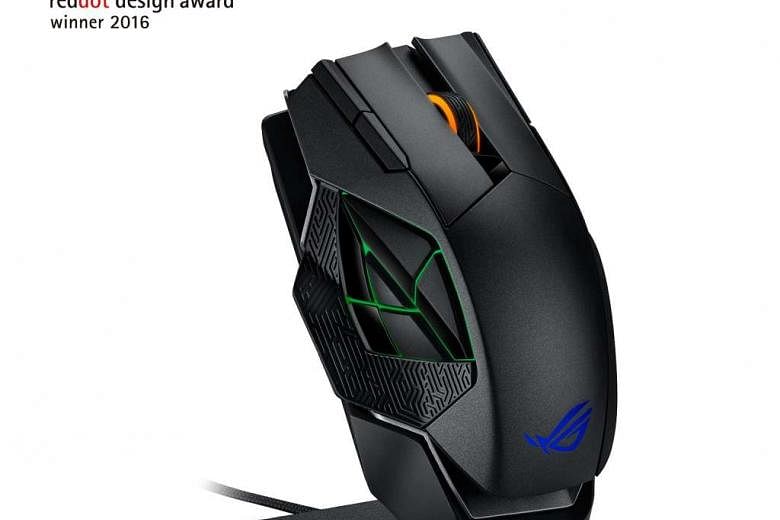The Asus Republic of Gamers Spatha gaming mouse makes a commanding first impression.
Named after a Roman sword, this matte black goliath weighs 175g without the cable. It is 13.7cm in length and 8.9cm wide.
When I hold the Spatha in my hand, it covers my entire palm and most of my fingers. It is heavy enough that it takes a noticeable effort to lift it off a mat.
In comparison, the Logitech G502 Proteus Core, another flagship gaming mouse, weighs 121g without the cable and has a smaller footprint of 13.2cm by 7.5cm.
The Spatha comes with a formidable set of extras. In the box is a hard carrying case, two cables (one rubber and one braided) and a two-in-one charging dock/wireless receiver. The Spatha is also the first mouse I have seen that comes with a screwdriver and two replacement switches.
Clearly, Asus has gone all out to make the Spatha an epic experience. But is the mouse any good?
-
TECH SPECS
-
PRICE: $259
DIMENSIONS: 13.7cm (L) x 8.9cm (W) x 4.5cm (H)
WEIGHT: 175g (without cable)
RESPONSIVENESS: 2,000Hz polling rate in wired mode; 1000Hz polling rate in wireless mode
RATING
FEATURES: 5/5
DESIGN: 3/5
PERFORMANCE: 4/5
VALUE FOR MONEY: 3/5
OVERALL: 4/5
Using the Spatha was certainly enjoyable. Though I prefer lighter mice, there was something about the heft of it that felt reliable and sturdy.
It tracked smoothly over a variety of surfaces, including wood and uneven cloth, such as a cushion or bed.
The flat charging dock that doubles as a wireless receiver is a great idea, as users can easily leave the Spatha on the pad to charge overnight, instead of having to regularly hook it up to the USB cable, like some other wireless mice.
The dock is also magnetised so that the mouse snaps right into place - a great example of Asus paying attention to detail.
The mouse itself is also crammed full of ergonomic elements, such as a rubberised thumb rest and curved mouse buttons.
However, the Spatha is definitely not meant for people with small hands. I found myself having to use a full palm grip instead of my usual claw grip in order to comfortably reach all the buttons.
The Spatha also feels like a victim of its own ambition, as it prioritises functions and features over usability. The mouse is optimised for massively multiplayer online games, and has a dozen programmable buttons.
But these are not easy to trigger. The six buttons in the thumb cluster are arrayed in a three-by-two set-up, but every single one is a different shape and size.
The biggest button is about three times as large as the smallest, and the lack of uniformity makes it difficult to use all six keys easily.
The DPI toggle button, which lies behind the scroll wheel, is also flush with the body of the shell instead of raised, making it hard to find in a cinch.
While I think that Asus has clearly made a great effort with the Spatha, some elements of its design need to be simplified in order for it to become a truly competitive mouse.
- Verdict: A lot of work has gone into making the Spatha epic, but it is let down by awkward button placement.


